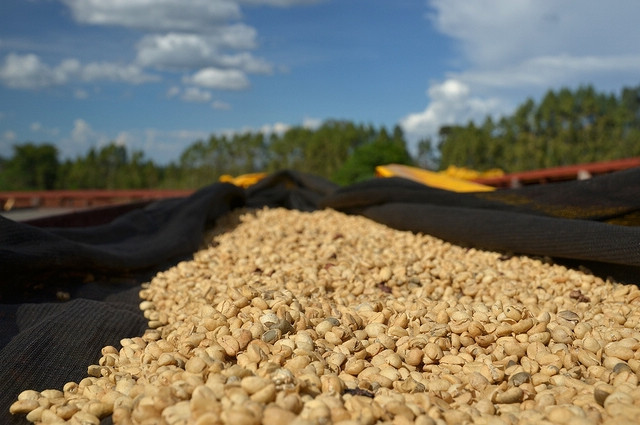Top Coffee in the World-- how Ethiopia chooses Sidamo to handle the Lion King
Although the Ethiopian Yirgacheffe coffee is petite, it is gentle and delicate and sweet. As the hometown of coffee, thousands of years of planting history and processing tradition in Ethiopia have created high-quality washed Arabica beans. Light baking has unique sweet aromas of lemon, flowers and honey, soft acidity and citrus flavors, fresh and bright on the palate. No milk or sugar, let the rich texture and unique soft flower scent brush your taste buds, leaving an endless aftertaste.
Yega Xuefei is a small town, 700-21000 meters above sea level, synonymous with Ethiopian boutique coffee. It has been a wetland since ancient times. The ancient saying "Yirga" means "settle down" and "Cheffe" means "wetland". The mode of production and flavor of coffee here is so outstanding that Ethiopian coffee farmers compete to be proud of the flavor of their coffee, making it the most famous coffee producing area in Africa.
At first, Yejassefi's coffee trees were planted by European monks, and later by farmers or cooperatives. Yega Xuefei is actually constructed by the surrounding coffee communities or cooperatives, including: Hafusha, Hama, Biloya.
These mountain villages are foggy, like spring all year round, with a gentle breeze in summer, cool but not hot, rain but not damp, and no cold damage in winter, giving birth to a unique regional flavor of citrus and flowers. Coffee trees are mostly planted in farmers' own backyards or mixed with other crops in the field.
Country: Ethiopia
Grade: G1
Production area: Guji
Planting altitude: 1800-2000m
Soil type: volcanic laterite
Annual rainfall: 1100-1200 cm
Treatment: insolation
Variety: native species (Heirloom)
Disposal site: Sirsa Cooperative
Raw bean specification: 17-18 mesh
Flavor: Jasmine, honey, citrus, ripe berries
The coffee flavor of Sidamo is very diverse, and the different soil types, microclimate and countless native coffee species make the coffee produced in each town have obvious differences and characteristics. In 2010-12, it won three consecutive high marks from coffee review 92 to 94, which shows the extraordinary value of raw beans in this area! The territory is covered by towering mountains, highlands, plateaus, valleys and plains with a variety of topography. The geology of the area belongs to the fertile and well-drained volcanic soil, which is nearly two meters deep and the surface soil is dark brown or brown. The biggest advantage of this place is that the soil fertility is maintained through the circulation of natural organic matter, with the withered leaves or litter of the surrounding trees and the residual roots of plants as natural fertilizer. This batch is produced by Sirsa Shilcho Cooperative near Dilla Town. The cooperative was founded in 1976 and is currently a member of the Sidamo Farmers' Cooperative Union SCFCU (Sidamo Coffee Farmer Cooperative Union). We have screened the coffee again and again and selected this batch for excellent flavor.
Ethiopia is the country where coffee was first discovered. Today, there is still a lot of wild coffee for farmers to harvest in the primeval forest. Ethiopia is a country with poverty, drought and civil war, but it is still the most important coffee producer in terms of coffee quality and output, and it is also the best and top coffee producer in the past year or two.
Ethiopian coffee can be divided into two treatments. Washing treatment method II. Natural sun treatment. Nowadays, every cooperative or even a small coffee farm in Ethiopia produces coffee beans of the above two treatments at the same time, whether it is the well-known Yegashev producing area in Taiwan or the Sidamo producing area. Not only that, in Ethiopia, which is currently the country with the fastest development of coffee, it not only makes coffee different in treatment, but also makes aroma and taste different due to the adjustment of different techniques and processes. Yegashev sun beans are different from Sidamo sun beans in aroma, which often gives people an illusion. The aroma is mild, low-sinking, citric acid is soft and low-key, the consistency of flavor is high, and the taste of Isopia coffee beans is won by taste, while the strong aroma of Esopia coffee beans shows strong aroma, the weak flavor of citric acid is not obvious, and the complex flavor is characterized by flower or fruit fragrance.
In recent years, many emerging small producing areas or cooperatives in the Sidamo and Yegashev producing areas will be sold in the international market under the name of their own cooperatives or farms, which shows confidence in their own coffee. Hope to establish brand and loyalty in the international coffee market, coffee farmers insist on harvesting mature coffee beans and strictly handle every process. Both natural washing and natural tanning are outstanding, with an unexpected extremely fragrant aroma and excellent taste. I think this is why Ethiopian coffee is expected by coffee fans every year. For example, the Dutch government-assisted Red Cherry Project (Operation Cherry Red) impressed the world with the magnificent aroma of strawberry cookies in 2008 and Cambedo Manor in 2009, which has been reinforced by the sun beans produced in Ethiopia in recent years.
Local farmers in West Dharma manually select moderately mature coffee cherries for sun treatment, turning the coffee cherries on the scaffolding every two hours during the sun for about 15 to 17 days. to ensure that the coffee cherries are evenly and completely dry, followed by shelling and packaging.
Flavor
Dried fragrance: wild ginger, jasmine, honey, lemon peel
Wet fragrance: honey sweetness, maple syrup, cream, citrus, flower aroma
Flavor: strong fruit tonality, rich fruit flavors such as cantaloupe, strawberries, peaches and ripe berries, silky texture, clean and balanced taste, full-bodied and changeable finish.

Important Notice :
前街咖啡 FrontStreet Coffee has moved to new addredd:
FrontStreet Coffee Address: 315,Donghua East Road,GuangZhou
Tel:020 38364473
- Prev

Peruvian specialty coffee Introduction Peruvian specialty coffee Origin Peruvian specialty coffee Features Peru
Peru is also a major coffee producer. Coffee production in Peru: As much as 98% of Peruvian coffee is grown in forested areas, and most producers are smallholders. The best coffee in Peru is produced in Chanchmayo, Cuzco, Norte and Puno. Most Peruvian coffee is grown under natural conditions, but it is also difficult to confirm
- Next

The main producing area of Peruvian coffee is the secret of taste and flavor of Peruvian coffee.
As a rising star in the coffee industry, Peruvian coffee is gradually opening up its popularity and entering the international market. Peruvian coffee has always been used as one of the stable and mellow mixed beans of comprehensive coffee. Peruvian coffee has a mellow taste and the right acidity, and this lukewarm coffee attitude has made more and more people like it. Peru is located in western South America, with a coastline of 2254 kilometers. Andes
Related
- Does Rose Summer choose Blue, Green or Red? Detailed explanation of Rose Summer Coffee plots and Classification in Panamanian Jade Manor
- What is the difference between the origin, producing area, processing plant, cooperative and manor of coffee beans?
- How fine does the espresso powder fit? how to grind the espresso?
- Sca coffee roasting degree color card coffee roasting degree 8 roasting color values what do you mean?
- The practice of lattes: how to make lattes at home
- Introduction to Indonesian Fine Coffee beans-- Java Coffee producing area of Indonesian Arabica Coffee
- How much will the flavor of light and medium roasted rose summer be expressed? What baking level is rose summer suitable for?
- Introduction to the characteristics of washing, sun-drying or wet-planing coffee commonly used in Mantenin, Indonesia
- Price characteristics of Arabica Coffee Bean Starbucks introduction to Manning Coffee Bean Taste producing area Variety Manor
- What is the authentic Yega flavor? What are the flavor characteristics of the really excellent Yejasuffi coffee beans?

